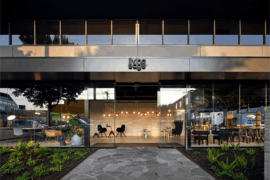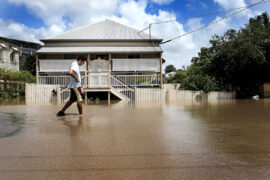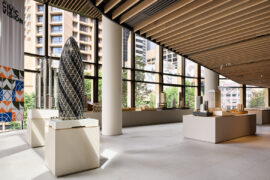In the second of a two-part exploration of hemp in today’s built environment, we consider risk and reward.

August 22nd, 2024
The first part of this story on hemp can be found here.
Regulation hoop-jumping
While hemp has recently been included in the BASIX system used in NSW, the National Construction Code for non-residential building does not recognise hemp as a standard material. Nor does it allow for expert opinion as a means of satisfying the performance requirements in Volume 1 for non-residential buildings. Instead, it requires rigorous, specific and costly physical testing or code-marking in a certified laboratory to demonstrate performance with fire and weatherproofing requirements, for example. This is all logical and understandable – we need to know our buildings are safe and have longevity built in – but this process can add up to $100k to a commercial project. That’s clearly prohibitive in many cases, and stifles innovation from all but the largest materials manufacturers.
All this means that larger commercial hemp projects require a significant amount of ideological, and financial, buy-in from the client. “A small business wouldn’t be able to get that done,” comments Alastair Flynn, Associate Principal at Woods Bagot. “Many clients couldn’t [carry the risk and cost], or they wouldn’t see the value in it.”

Risky business
Anna Maskiell of Public Realm Lab knows first-hand the risk and effort it takes to bring a significant hemp project to life. The Mildura Powerhouse project, recently awarded several prizes at the Victorian Architecture Awards, was the culmination of several years’ worth of internal research, site visits and prototyping in its hemp masonry construction.
“It’s unknown, relatively speaking and from a regulatory point of view, for public projects. So, in terms of getting your building permits, so there’s a whole regulatory stream that’s very complex. From a procurement stream perspective and for commercial builders, it’s an unknown system,” she says. “In terms of its risk profile, it attracts a whole bunch of additional costs, and the procurement stream is very complex. Even if you manage to get to the point where you’ve got a client on board and you’ve got what looks like a smooth regulatory process – actually taking it to market is incredibly complex. We already operate in a space of a lot of risk and complexity, and it does add to it,” she admits.

High reward
All this makes it difficult for hemp to scale up to commercial-grade buildings, but with Mildura Powerhouse a success and University of Tasmania set to add to the precedent case studies, the hemp wave may have begun.
“Luckily for us, Anna [Maskiell] actually kicked the door down before we did in time because [her] project was running about a year and a half ahead of ours,” shares Dick about Envirotecture’s 560-square metre multi-function Women’s Shed in Lithgow currently under construction, which also uses hemp for all its external walls. “We were able to actually use some of the material that she had put together, and the fact that the certifier in Victoria had accepted it I think had an influence on the certifier we were dealing with in New South Wales,” he continues.

The growing hemp wave
‘There is very little resistance and a great amount of enthusiasm for hemp,’ says Clarke. ‘Most architects and designers I’ve come across have a will and a basic, if not detailed, understanding of the carbon debt that conventional buildings incur and the need for high performance in operation.’
Maskiell is similarly hopeful: ‘It feels like it could be a significant shift, and it’s building momentum, but it also feels very vulnerable at the same time. So it’s incredibly exciting but it also needs careful, considered advocacy and delivery.’ Using precedents and harnessing the growing knowledge and willpower of the collective, the Australian Hemp Council has brought together a task force to actively mainstream hemp’s use in design and construction via strategic campaigns to adjust regulatory systems such as the Australian Standards and building codes.


A lot of work is needed; however, the passion of the hemp advocates is unwavering, whilst their experience and expertise grow, and case studies mount. At this early stage, collaboration is clearly critical. “There was no single party that could have pulled this off without collaboration with others, so you’ve just got to get your heads together. If you think you have the right client and the right contractor, you can achieve this kind of innovation,” says Flynn.
Along with Mildura Powerhouse, the University of Tasmania buildings will be accessible to the public – achieving the kind of exposure that could also influence the material’s trajectory. “The nice thing about this project is people will walk off the street into the space and actually see it,” Flynn continues. “It will be really good for people to experience.”
Every project and every individually financed certification and test help to unlock the potential of this remarkable material. With more and more hemp products on the market, the tide looks set to turn. “Now we’re working with every other hemp product we can get our hands on that is appropriate, with the relevant requirements for the project we’re doing,” says Anna. “So, we’re using prefabricated hemp block, and looking at prefabricated panels.
“We just need to make the revolution irresistible.”
Go here for the first part of this hemp investigation.





INDESIGN is on instagram
Follow @indesignlive
A searchable and comprehensive guide for specifying leading products and their suppliers
Keep up to date with the latest and greatest from our industry BFF's!

London-based design duo Raw Edges have joined forces with Established & Sons and Tongue & Groove to introduce Wall to Wall – a hand-stained, “living collection” that transforms parquet flooring into a canvas of colour, pattern, and possibility.

The undeniable thread connecting Herman Miller and Knoll’s design legacies across the decades now finds its profound physical embodiment at MillerKnoll’s new Design Yard Archives.

Welcomed to the Australian design scene in 2024, Kokuyo is set to redefine collaboration, bringing its unique blend of colour and function to individuals and corporations, designed to be used Any Way!

For Aidan Mawhinney, the secret ingredient to Living Edge’s success “comes down to people, product and place.” As the brand celebrates a significant 25-year milestone, it’s that commitment to authentic, sustainable design – and the people behind it all – that continues to anchor its legacy.

David Gole, principal at leading climate-resilient design practice JDA Co., comments on the intersection between heritage and climate in architecture.

Civic Vision, a major exhibition showcasing the global work of Foster + Partners, has officially opened in Sydney.
The internet never sleeps! Here's the stuff you might have missed

Civic Vision, a major exhibition showcasing the global work of Foster + Partners, has officially opened in Sydney.

The New York headquarters of haircare brand, Amika, has been designed by Civilian as the antithesis of a standard business hub.